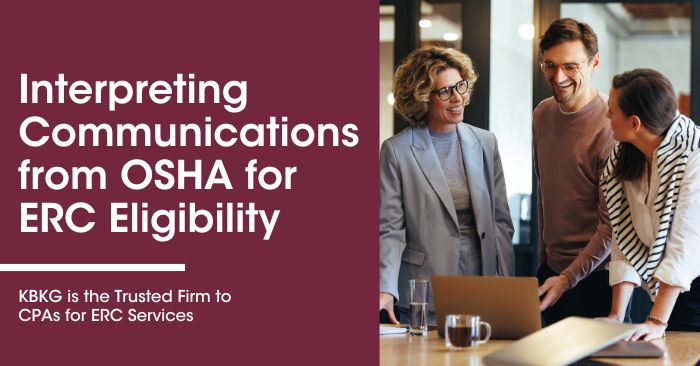Interpreting Communications from the Occupational Safety and Health Administration (OSHA) for ERC Eligibility
Thought Leadership by KBKG
WARNING IRS issues further guidance that reliance of OSHA guidelines does not meet standards of government orders for ERC. If you or your ERC provider used OSHA guidelines as a reason for a government shutdown your credits are not likely to meet legal requirements and you could be at risk of penalties and other action by the IRS.
The Coronavirus Aid, Relief, and Economic Security Act (CARES Act) and the Internal Revenue Code (Code) provide an employee retention credit (ERC/ERTC) for employers who experienced a full or partial suspension of their business operations due to COVID-19. To qualify for the ERC, employers must demonstrate that they were subject to orders from an appropriate governmental authority limiting commerce, travel, or group meetings due to COVID-19.
In recent years, the Occupational Safety and Health Administration (OSHA) has issued various communications guiding mitigating and preventing the spread of COVID-19 in the workplace. These communications have ranged from general recommendations to more specific directives.
The question arises whether these OSHA communications can be considered “orders” to qualify for the ERC.
Answer:
The answer to this question needs to be clarified. The IRS has not issued any specific guidance on this issue. However, based on the existing guidance on the ERC, it is likely that OSHA communications would solely be considered “orders” if they are:
- An appropriate governmental authority issues it. OSHA is a proper governmental authority for purposes of the ERC.
- They were limiting commerce, travel, or group meetings. OSHA communications that provide general recommendations or guidance on mitigating and preventing the spread of COVID-19 in the workplace are unlikely to be considered orders. However, OSHA communications that specifically mandate specific actions by employers, such as requiring employers to close their workplaces or limit the number of employees on-site, could be considered orders.
- Due to COVID-19. OSHA communications must be issued in response to the COVID-19 pandemic to be considered orders for purposes of the ERC.
Scenarios:
In Scenario 1, Employer A is not likely to be considered an eligible employer for the ERC because the state and local jurisdictions it operates have lifted all COVID-19-related health orders and restrictions. As a result, Employer A was not subject to any mandates from an appropriate governmental authority that limited commerce, travel, or group meetings due to COVID-19.
In Scenario 2, Employer A may be considered an eligible employer for the ERC, even though it did not experience a full or partial suspension of its business operations. This is because OSHA communications may have caused Employer A to take specific actions that reduced its business activities, such as requiring employees to wear masks or practice frequent handwashing. However, Employer A must provide documentation to support its claim that OSHA communications caused it to take these actions.
Additional Notes:
- The ERC is a complex tax credit, and there are many other factors that employers must consider when determining whether they are eligible.
- The IRS has provided extensive guidance on the ERC, and this guidance should be consulted before claiming the credit.
- Employers should consult a tax advisor to comply with all applicable laws and regulations.
Additional Information on the Occupational Safety and Health Act (OSH Act):
Section 5(a)(1) of the OSH Act:
Section 5(a)(1) of the OSH Act, 29 USC § 654(a)(1), known as the General Duty Clause, requires each employer to furnish to each of his employees employment and a place of employment free from recognized hazards that are causing or likely to cause
Section 6 of the OSH Act:
Section 6 of the OSH Act, 29 USC § 655, provides that OSHA can adopt occupational safety or health standards and emergency temporary standards. Occupational safety and health standards require conditions or the adoption or use of one or more practices, means, methods, operations, or processes reasonably necessary or appropriate to provide safe or healthful employment and places of employment.
Conclusion:
The issue of whether an employer may rely on OSHA communications to meet the definition of an “eligible employer” for purposes of the ERC is complex. Employers should carefully review the relevant guidance and consult a tax advisor to determine whether they may be eligible for the ERC.
Additional Guidance:
- Notice 2021-20, Section III.C., Q&A 10
- Notice 2021-20, Section III.D., Q&A 11
- Notice 2021-20, Section III.D., Q&A 15
- Notice 2021-20, Section III.D., Q&A 16
- Notice 2021-20, Section III.D., Q&A 18
- Notice 2021-20, Section III.D., Q&
Related Pages
- Supply Chain Disruption – How to Get Compliant for the ERC
- Employee Retention Tax Credit – Benefit Estimate
- Where is My Employee Retention Credit Refund?
- KBKG Tax Insight: IRS warns Taxpayers of Improper Employee Retention Credit Claims and ERC Mills
- KBKG Tax Insight: IRS To Target Abusive ERTC Claims. Analysis of Government Shutdown & Supply Chain Rules
- It’s Not Too Late to Claim Employee Retention Tax Credits
- The Employee Retention Tax Credit (ERC): What Small Businesses Need to Know


